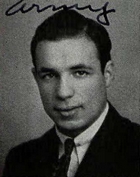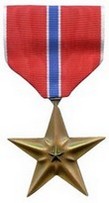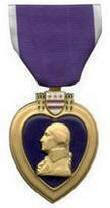Walt Rougeux
| Date and Place of Birth: | May 9, 1922 Clearfield, PA |
| Date and Place of Death: | May 12, 1945 Okinawa |
| Baseball Experience: | Minor League |
| Position: | Third Base |
| Rank: | Radioman First Class |
| Military Unit: | US Navy |
| Area Served: | Pacific Theater of Operations |
Walter L. Rougeux, the son of Mr. and Mrs. Basil O. Rougeux, was born on
May 9, 1922 in Clearfield, central Pennsylvania. Rougeux hit .426 his
senior year at Clearfield High School in 1941, as the Bisons posted a
15-0 record, as well as quarterbacking the Western Conference
championship football team. During the summer of 1941, he played sandlot
baseball with the Lumbermen and the Dark Horses.
In 1942, he joined the Clearfield Indians, local entry in the Jefferson
County League, while also playing in the Twilight League with the
Clearfield Moose nine. On July 13, 1942, the 20-year-old third baseman
was signed and made his debut with the Class D PONY League’s Bradford
Bees. Rougeux played 14 games and batted a respectable .264 for skipper
Jack Burns, a former big leaguer Jack Burns. However, the Bees were a
farm club of the Boston Braves and the parent club insisted their young
third baseman, Bob Garieppy, get more playing time. Rougeux was benched
and decided to return to Clearfield in early August, rather than sit out
the remainder of the season in Bradford. Nevertheless, Rougeux impressed
Burns as he was asked to return to the club the following spring. As a
side note, Garieppy hit just .154 in 25 games and was never seen again
in pro ball.
Rougeux never made that spring appointment with the Bradford Bees as he
enlisted in the Navy in September 1942, and trained at Great Lakes Naval
Training Station, where he played some basketball. He then attended
radio school at the University of Wisconsin, and was sent to the Naval
Radio Transmitting Station, Bainbridge Island, Washington. From there,
he went to the Skaggs Island Naval Communication Station, California.
Rougeux was then sent to the Hawaiian Islands for an extensive study of
the Japanese language.
Bill Holmes, secretary of the Clearfield Baseball Association, kept in
touch with all the 1941-1942 ballplayers who were in military service.
By 1944, 25 former players were in service and Holmes received a letter
from Radioman 2nd Class Rougeux in the Pacific Theater. In part, Rougeux
said, “Glad to hear that Clearfield was able to have a twilight league
at least. I have done a little playing since I was in the service, but
not enough to suit me. At radio school at the University of Wisconsin I
played on the varsity team, from there I went to the west coast. I
played a little pro ball while I was there, was playing for a ship yard
team [probably at Bremerton Ship Yard). I had a home run with the bases
loaded there to break up a deciding game. Over here I haven’t played
much baseball. We play softball most of the time, as we don’t have
enough time off to organize a baseball team. About two weeks ago we had
a hard ball game, we played another Navy team. They had a kid pitching
for them who was with the Detroit Tigers. He sure had a fastball. They
beat us 3 to 2. Wish I could be there playing again but I guess will
have to wait ‘til this thing is over.”
In March 1945, Rougeux, joined the battleship USS New Mexico (BB-40), as
part of the Fifth Fleet’s radio intelligence unit. Throughout March and
April, the New Mexico supported troops ashore at Okinawa. While
approaching her berth at Hagushi bay, Okinawa, just after sunset on May
12, 1945, the battleship was attacked by two Japanese kamikazes. One hit
the ship while the other successfully dropped its bomb. Instantly set on
fire, 54 members of New Mexico's crew were killed, while a further 119
were wounded. RM1c Walter L. Rougeux was among the
fatalities. He was buried at an Allied cemetery on an island in the
Pacific.
In May 1946, Rougeux was posthumously awarded the Bronze Star for
meritorious achievement. The citation read as follows: "For meritorious
achievement while serving as a radioman, attached to the 5th Fleet radio
intelligence unit, during action against enemy Japanese forces in the
Pacific war area from March 9, to May 12, 1945. Working tirelessly and
with superb technical skill in the performance of his exacting
assignment, Rougeux rendered invaluable assistance to the Commander 5th
Fleet during our amphibious assault at Okinawa and devastating carrier
raids against Kyushu and hostile Fleet units in the Inland Sea. His
outstanding ability and constant devotion to duty throughout this period
of extensive operations to extend United States control westward reflect
the highest credit upon Rougeux and the United States Naval Service."
In August 1946, a copy of “Earth, Moon and Planets” by Fred L. Whipple
was placed in the Clearfield Library in memory of Walt Rougeux. In
October 1946, his name was unveiled on a bronze plaque alongside 26
other Clearfield High School graduates who gave their lives in World War
II. The plaque was put on display in the high school’s east hall.
On March 14, 1949, following the return of his remains from the Pacific
aboard the U.S. Army Transport Dalton Victory, Walt Rougeux was buried
at Calvary Cemetery in Clearfield, Pennsylvania, after military funeral
services at the St. Francis Catholic Church.
Thanks to Jack Morris for “discovering” Walt Rougeux so he could be added to the Baseball’s Greatest Sacrifice site.
Date Added March 16, 2016
Baseball's Greatest Sacrifice is associated with Baseball Almanac
Baseball's Greatest Sacrifice is proud to be sponsored by



